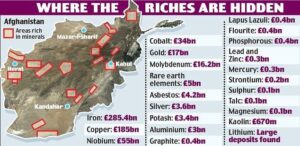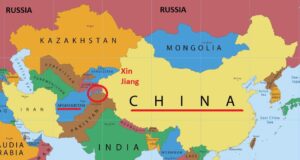Afghanistan’s humanitarian crisis turned to capitalistic opportunity

TORONTO – American “Manifest Destiny”– in today’s terms, unrestrained colonialism – justified the occupation of the aboriginal territory, ethnic cleansing and colonial warfare in the nineteenth century” by associating a quasi-religious ethos with the more covert, crass objective: “there’s gold in them there hills”.
So it is with the perennial international political graveyard that is Afghanistan. The country appears to have, once again, rejected outright the influence of “westernized secular democratic civilization” whose ultimate expression is based on international human rights, equality etcetera. The humanitarian issues, always cited as reasons for Western intervention in an area rooted in values neither historians nor psychologists can claim to understand, are once again nothing more than a passing glance at “what might be”.
Maybe their values are so innately different that they fail to understand our concern for half their population: their women and girls.
They understand supply and demand. The price of a burqa, absent which no woman dare be caught for fear of reprisal and punishment, just went up tenfold, according to local reports. The “protection racket” must be booming because no woman can appear in public unescorted by “a male relative”.
After twenty years of Western “supervision” (US led occupation in which we participated), everything has “gone back to normal”. For women, that means they can live in fear of their sons, husbands, brothers… you know, their male relatives.
For the poppy/opiates/heroin producers and traders responsible for 84% to 95% of the world supply and the criminal organizations it supports, it should be good times ahead.
The US and European markets for those products seem confused on their public policy objectives vis a’ vis the flooding of their societies with the deadly opiates emanating from the world’s biggest supplier.
Neither Russia nor China are as confused. Unlike the chaotic North American and British retreat, both countries appear to be in rapprochement mode with their neighbour. Neither of them is burdened by religious or gender concerns with respect to Islamic militancy in the form of the Taliban rulers.

They appear to demonstrate a purely pragmatic political/economic objective of positioning themselves as potential partners to commercialize the abundant natural resources, so far relatively undisturbed, that both US geologists and Afghani government reports claim are there for the exploitation.
If one can overcome the humanitarian concerns (90% of the population lives on less than $2 per day) a co-ordinated development of natural resources could transform the 40 million inhabitants into wealthy middle class. The value of its untapped Lithium deposits (crucial for e-vehicles) was estimated by Afghan’s Minister for Mines at $ 3 Trillion USD – ten years ago.
The list goes on. The country has large reserves of copper, gold, oil, natural gas, uranium, bauxite, coal, iron ore, rare earth, chromium, lead, zinc, gemstones, talc, sulphur, travertine, gypsum and marble, as per various reports put forth by the Afghan government and the US.
The country’s copper reserves alone, estimated at almost 30 million tonnes by Afghanistan’s Ministry of Mines and Petroleum in a 2019 report, are worth hundreds of billions of dollars.
The maps are taken from Twitter profile “Kun Fayakun” (the first one) and from the website http://www.madrerussia.com (the second one)


